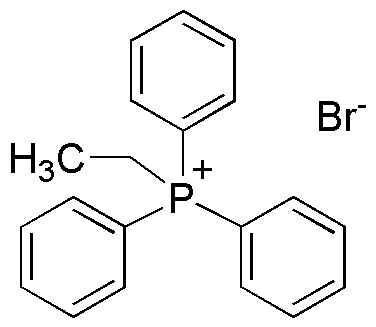Ethyltriphenylphosphonium bromide is widely utilized in research focused on:
- Organic Synthesis: This compound serves as a key reagent in various organic reactions, particularly in the synthesis of phosphonium salts and other organophosphorus compounds, facilitating the creation of complex molecules.
- Phase Transfer Catalysis: It acts as an effective phase transfer catalyst, enhancing the efficiency of reactions between organic and aqueous phases, which is beneficial in industries like pharmaceuticals and agrochemicals.
- Biological Studies: Researchers use it to investigate biological systems, as it can help in the study of membrane transport and cellular processes, providing insights into drug delivery mechanisms.
- Material Science: The compound is applied in the development of advanced materials, including polymers and nanomaterials, where it contributes to improved properties such as conductivity and stability.
- Analytical Chemistry: It is utilized in analytical methods for the detection and quantification of various substances, aiding in quality control and research applications across multiple sectors.
General Information
Properties
Safety and Regulations
Applications
Ethyltriphenylphosphonium bromide is widely utilized in research focused on:
- Organic Synthesis: This compound serves as a key reagent in various organic reactions, particularly in the synthesis of phosphonium salts and other organophosphorus compounds, facilitating the creation of complex molecules.
- Phase Transfer Catalysis: It acts as an effective phase transfer catalyst, enhancing the efficiency of reactions between organic and aqueous phases, which is beneficial in industries like pharmaceuticals and agrochemicals.
- Biological Studies: Researchers use it to investigate biological systems, as it can help in the study of membrane transport and cellular processes, providing insights into drug delivery mechanisms.
- Material Science: The compound is applied in the development of advanced materials, including polymers and nanomaterials, where it contributes to improved properties such as conductivity and stability.
- Analytical Chemistry: It is utilized in analytical methods for the detection and quantification of various substances, aiding in quality control and research applications across multiple sectors.
Documents
Safety Data Sheets (SDS)
The SDS provides comprehensive safety information on handling, storage, and disposal of the product.
Product Specification (PS)
The PS provides a comprehensive breakdown of the product’s properties, including chemical composition, physical state, purity, and storage requirements. It also details acceptable quality ranges and the product's intended applications.
Certificates of Analysis (COA)
Search for Certificates of Analysis (COA) by entering the products Lot Number. Lot and Batch Numbers can be found on a product’s label following the words ‘Lot’ or ‘Batch’.
*Catalog Number
*Lot Number
Certificates Of Origin (COO)
This COO confirms the country where the product was manufactured, and also details the materials and components used in it and whether it is derived from natural, synthetic, or other specific sources. This certificate may be required for customs, trade, and regulatory compliance.
*Catalog Number
*Lot Number
Safety Data Sheets (SDS)
The SDS provides comprehensive safety information on handling, storage, and disposal of the product.
DownloadProduct Specification (PS)
The PS provides a comprehensive breakdown of the product’s properties, including chemical composition, physical state, purity, and storage requirements. It also details acceptable quality ranges and the product's intended applications.
DownloadCertificates of Analysis (COA)
Search for Certificates of Analysis (COA) by entering the products Lot Number. Lot and Batch Numbers can be found on a product’s label following the words ‘Lot’ or ‘Batch’.
*Catalog Number
*Lot Number
Certificates Of Origin (COO)
This COO confirms the country where the product was manufactured, and also details the materials and components used in it and whether it is derived from natural, synthetic, or other specific sources. This certificate may be required for customs, trade, and regulatory compliance.


